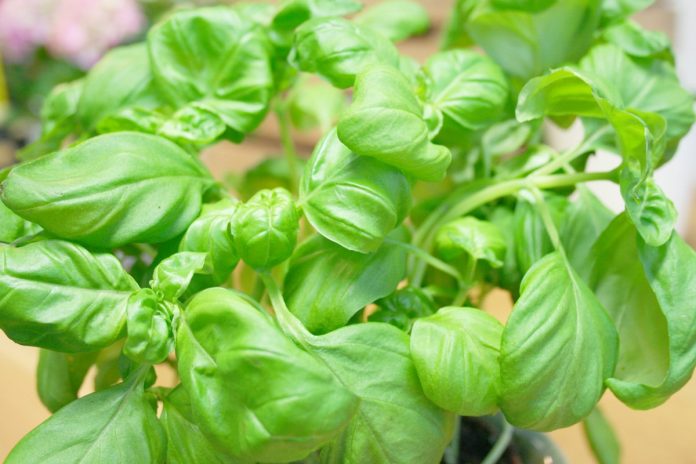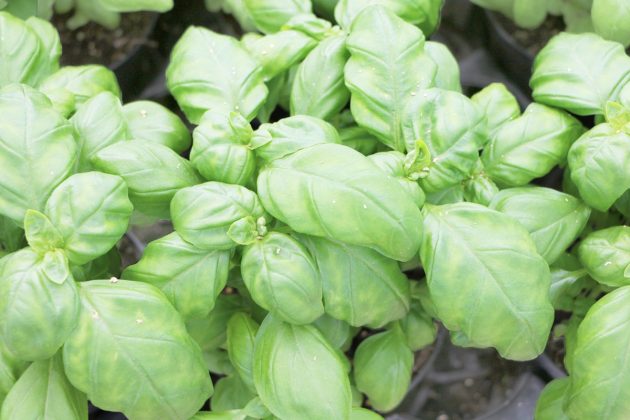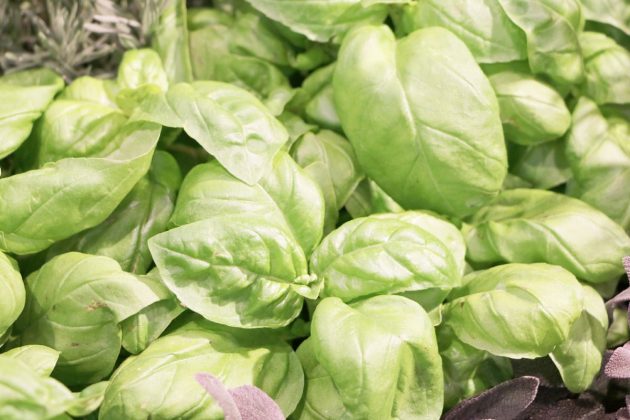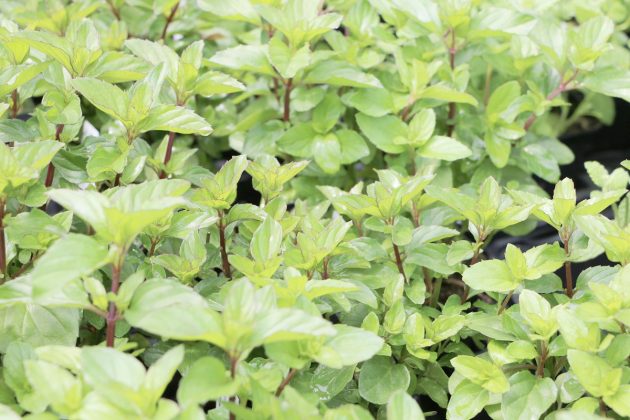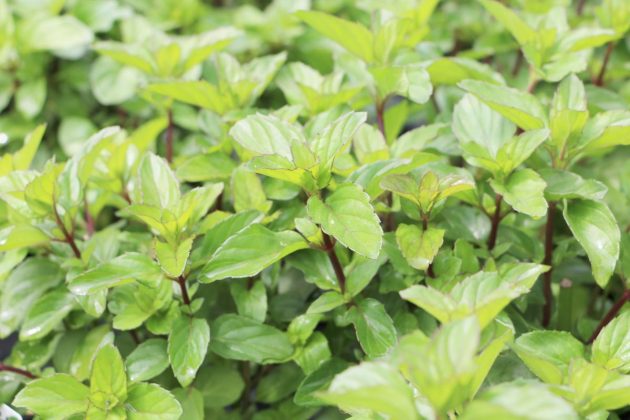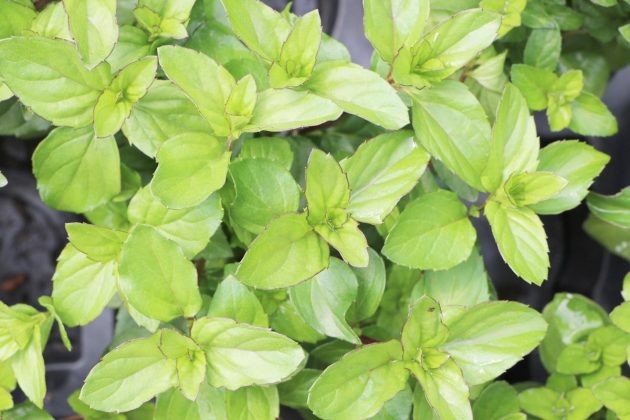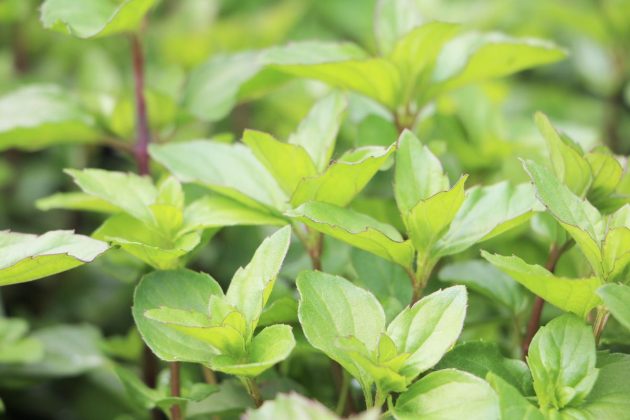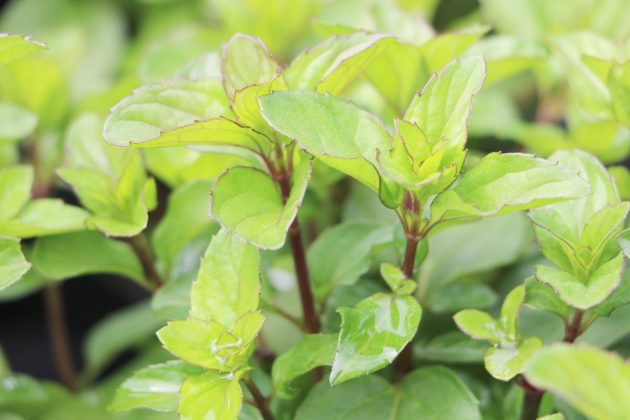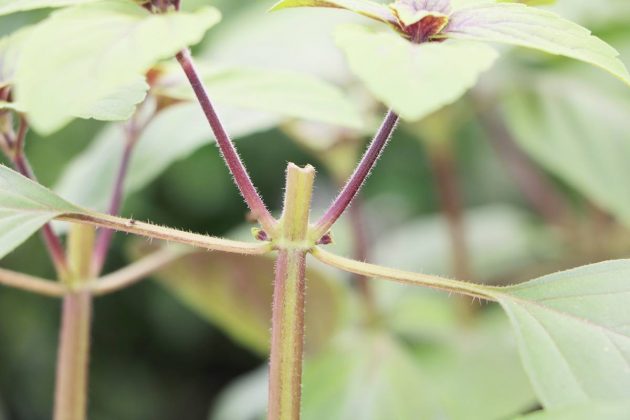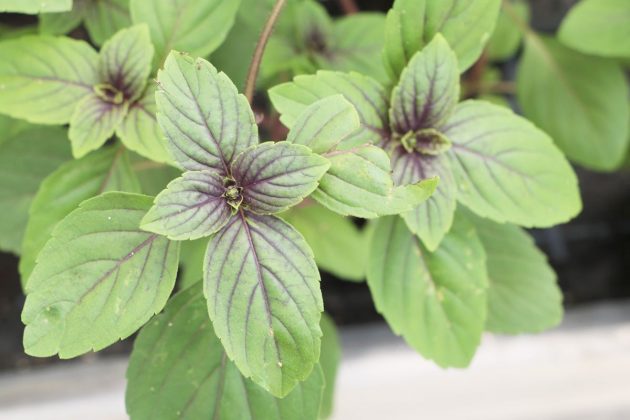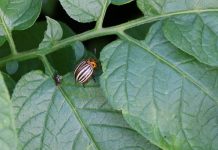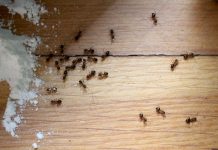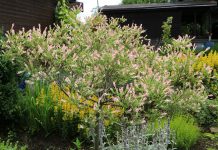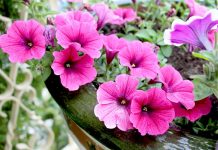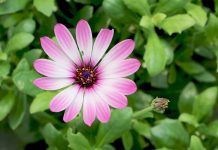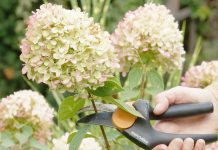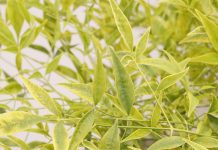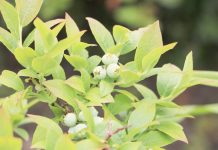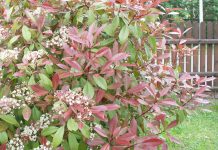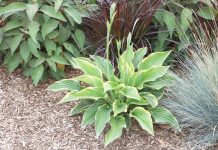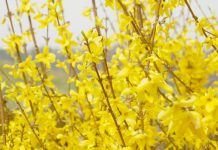Basil belongs to the most popular herbs and makes the special something and Mediterranean pep in a lot of, especially Italian dishes. It gently smells like essential oils and as a fresh herb, it is also rich in vitamins. Since basil originates sunny, warm regions, some details in caring must be considered so it can grow in local areas. This care guide will tell you more about these.
Plant Profile
Contents
- Plant family: Labiates (Lamiaceae)
- Genus: Ocimum
- Species: Basil (Ocimum basilicum)
- Trivial names: Royal herb, Saint-Joseph’s wort
- Origin: Northwest of India
- Herbaceous, perennial or annual plant
- Height: from 20 centimeters up to 60 centimeters
- Flowering period: June to September
- Multiple-flowered white cymes
- Aromatic scent
- Contains essential oil
- is cultivated as spice, ornamental or medicinal plant
A healthy and, above all, delicious herbal plant is the Ocimum, which found its way from the Mediterranean regions to the colder parts of Europe decades ago. In addition, basil is also a medicinal plant which, among other aspects, has an anti-inflammatory, appetizing effect and a regulating effect on the gut flora.
As a herb from tropical areas, it makes various demands on the local climate zone. Especially when cultivated in pots, the basil is usually not comfortable. This care guide describes in detail, how to make your basil grow abundantly in the local area and how it is reaped.
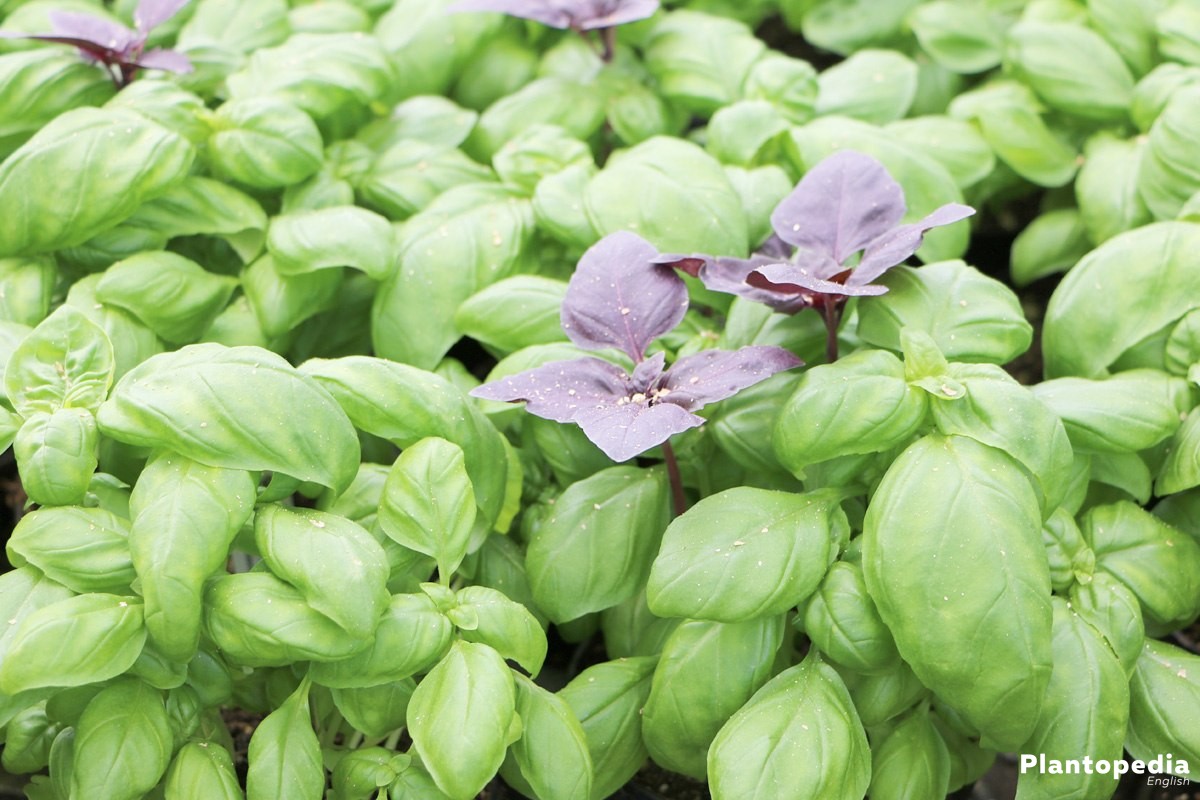
Care
Speaking in general, this herbal plant does not require extensive care or complex cultivation scenarios. You only need to keep some details in mind, especially when planting, that are necessary for a healthy growth so you can refine your dishes with the Mediterranean flair of fresh basil.
Location
Due to its origin, the perfect location has to be sunny. Depending on the variety, the royal herb prefers a temperature of 20 degrees Celsius or more, or a rather cool place below 20 degrees Celsius. Cooler temperatures, for example, are suitable for the wild basil and the African Blue. Below a temperature of 12 degrees Celsius, however, each type of basil will stop growing.
Besides that, you should also note the following:
- avoid cold drafts
- when planting in beds or in pots on balconies or terraces, the growth will be more luxuriant
- when the temperature drops below 10 degrees Celsius, the herb plant must be taken to the warm inside
- the basil does not tolerate rain with strong sun exposure
- inside, the royal herb prefers a bright spot on the window, without direct sun
- spots above radiators are not suitable during the heating period and provoke the plant to dry
- the herb is advantageous near tomatoes, since it protects these from numerous pests
- thai and Tulsi varieties of the basil are only suitable for cultivation inside or in a greenhouse
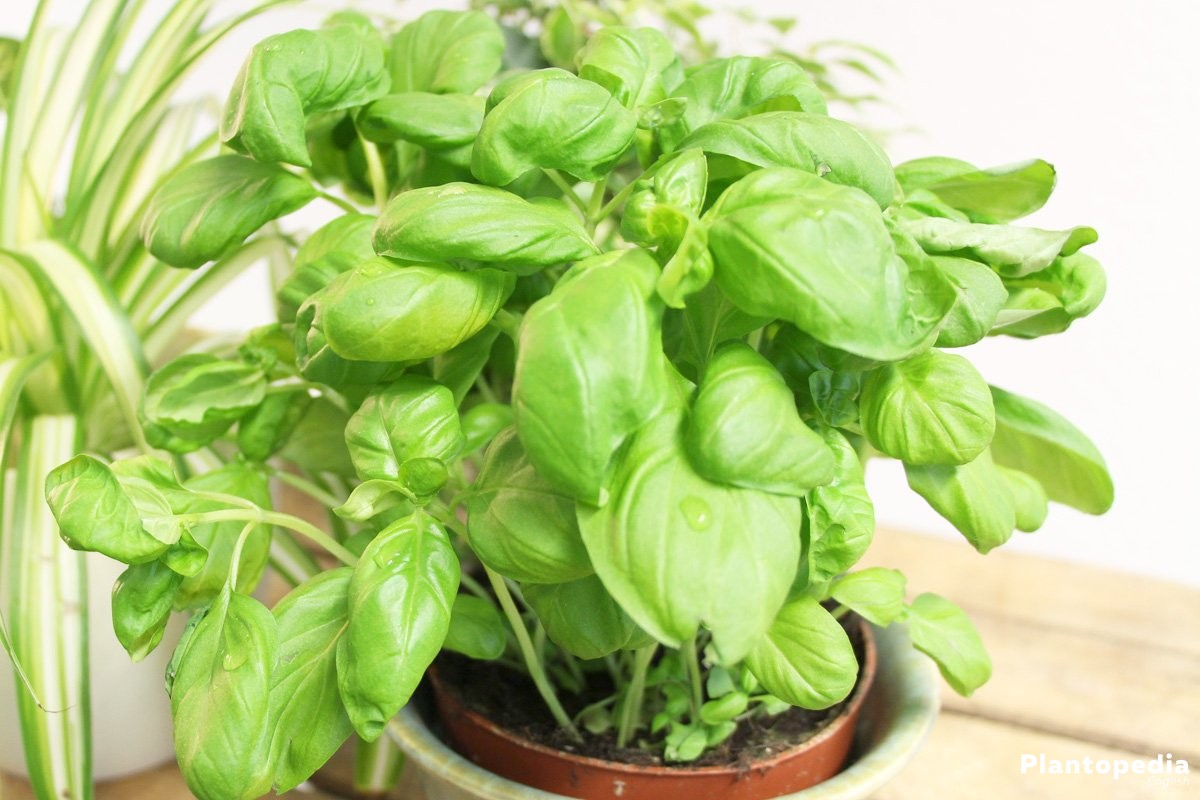
Soil condition
Especially the right soil condition is decisive for a healthy plant and full growth. For this purpose, some foundations should be laid.
- loose soil quality that absorbs heat
- nutrient-rich, humous and permeable soil
- freshly-damp soil
- might also be somehow sandy
- recommended pH: 6.5 to 7.2
Substrate
You would expect the basil to feel comfortable in special herbal soil. However, it does not, since herbal substrates do not meet the needs of the basil. A compost-based substrate is recommended. Further ingredients such as sand, perlite as well as expanded clay or an amount of coconut fiber ensure a better permeability of the substrate.
Planting period
In the open, the royal herb should never be planted before the Frost Saints in the middle of May. Furthermore, the temperature must be constantly above 12 degrees Celsius. For many varieties, a minimum temperature around 20 degrees Celsius is perfect, which can usually be expected by the middle/end of July.
If the basil has been given a place in the greenhouse with ideal temperature conditions, it can be planted or potted all the year. However, in winter the cultivation period is increased by about twice as much to 80 to 100 days.
Planting in the bed
The wild basil as well as the African Blue variety are ideal for planting in the flower bed, since they are better at coping with cold temperature fluctuations in spring. All other varieties enjoy being outside, too, when the temperatures are warmer.
This is how to proceed when planting in beds:
- first of all, accustom the plants from the supermarket or greenhouse to the fresh air.
- leave the pot in a shaded place for about five to six days
- after that, choose a sunny spot and excavate a plant hole
- the plant hole should have a minimum diameter of 30 centimeters and be twice as deep as the root ball
- create a two-centimeter high drainage of quartz sand or gravel on the ground
- mix the excavated soil with compost or a suitable substrate
- place the Ocimum basilicum in the middle
- fill the soil in such a way that the root base is covered about two centimeters
- press the soil slightly and water generously
Planting in the pot
When fresh basil in a pot is bought from the supermarket, it usually does not last much longer than a few days. This is because it suffers a stressful delivery under various conditions. Besides that, a leached substrate is used and/or the pot is much too small for the plant.
If you have bought basil in a pot, it is advisable to instantly repot it. Use a larger pot and, above all, a substrate as described in the relevant section of this guide. Some professional gardeners also recommend parting the roots and pot every plant part separately. This usually gives the herbal plant more strength so it can handle long transportation distances, storage times as well as fluctuations in temperature and light better.
When potting, proceed the same way like when planting in beds. Make sure that the pot has a hole in the bottom so excess water can run out.
Watering
The leaves of the Ocimum basilicum are very sensitive to moisture, if the sun shines afterwards. This causes burns that can lead to a fast drying and withering of the leaves of the royal herbs. Accordingly, the plant should generally either be protected from the hot midday sun or from rain and when pouring, the leaves are completely left out. Spraying during the sunshine is not advisable, either.
In order to avoid the expenditure on watering, you can put the royal herb in a dipping bath every five days. Leave it there for about five minutes, so the plant can saturate. Then drain excess water and put the pot back to its usual location.
The best time for pouring is when the soil’s surface is slightly dry. You can easily check this by doing the thumb test. If you can push in the surface of the soil more than two centimeters, it is still wet enough. If it is less than two centimeters, it is time for pouring. Avoid causing waterlogging, since this stimulates mould growth and accelerates the wilting. Only use room temperature water.
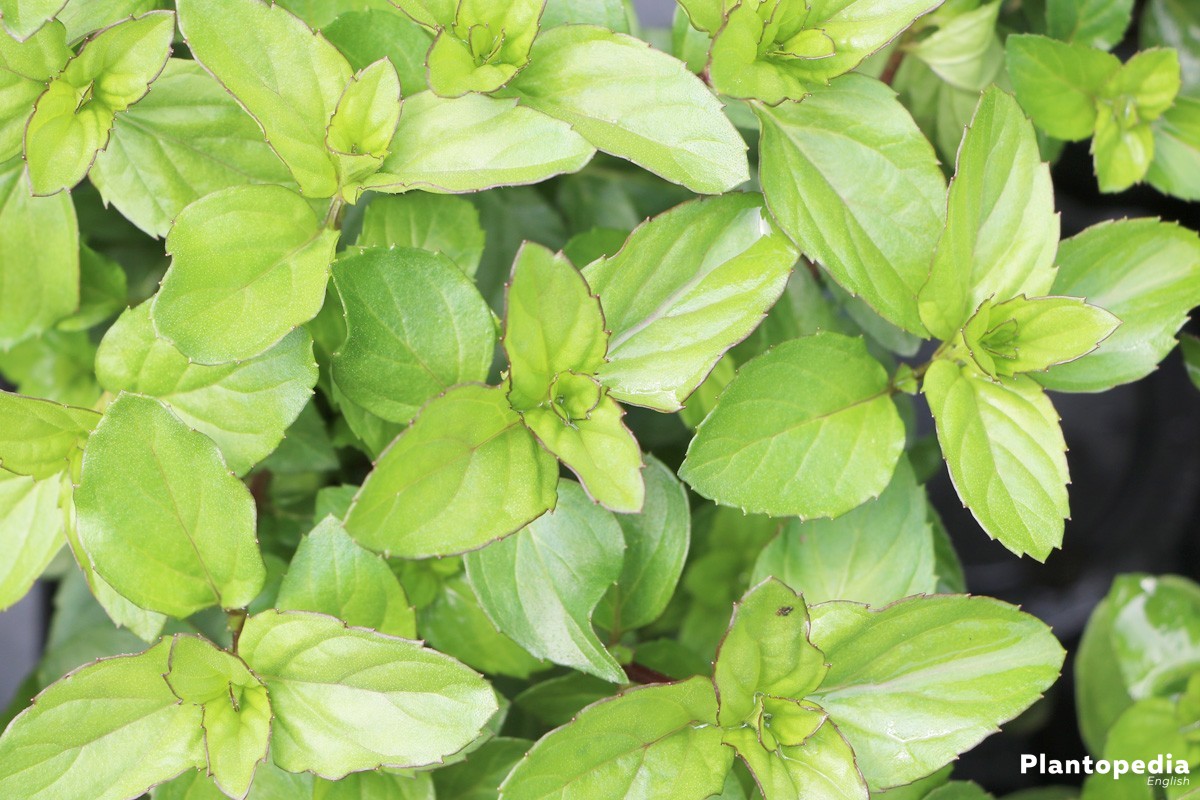
Fertilizing
When cultivated in a pot, the basil is fertilized once a week. It is best to use an organic liquid fertilizer on a natural basis. Outdoors, the expenditure on fertilizing is reduced to about once in every six weeks. In that case, use a fertilizer with nitrogen content.
Trimming
Cutting the basil is one of the most important details in caring and harvesting. The fast growing plant becomes thin rapidly, so a cutback to about five centimeters is recommended to achieve a denser, more luxuriant growth.
In the case of an annual plant, cut off all the shoots including the buds to prevent it from flowering, because after the flowering, the Ocimum basilicum stops growing. You can either use the cut off parts instantly, dry or freeze them. For perennial plants, the winter phase begins in October, when they nearly completely cease their growth. The only reason for cutting then is for harvesting.
Harvesting
Especially when harvesting, there is much that can be done wrong and will cause the plant to die prematurely.
This is why you should proceed as follows:
- do not tear off single leaves, but always a whole branch
- do not kink the branch, but use a disinfected cutting tool such as a knife or scissors
- in general, you should cut about one to two centimeters above a leaf pair, so branched shoots will grow

If a lush growth occurs, you can cut off a leave occasionally, without causing damage. However, this should not be the rule.
Overwintering
Speaking in general, most varieties of the basil are annual plants which fade away at the latest in September after flowering. Overwintering is unnecessary.
Perennial specimens that are cultivated outside, are to be put in the greenhouse or in a heated room, at the latest when the temperature outside drops to 12 degrees Celsius. The optimal temperature during the winter months is between 15 degrees Celsius and 20 degrees Celsius. Put the Ocimum basilicum in a bright place and pour only every few days when the soil is slightly dry.
If heating air reduces the humidity, it is advisable to spray the herbal plant regularly. Since it is not good at withstanding the rising heat from radiators in winter, it is advisable to place a heat protection of Styrofoam or something similar with isolating properties under the pot.
Propagating
To make sure you do not always have to buy basil and have many of it, you can easily propagate your stock in different ways.
Sowing
As the flowers slowly fade in September, it is the perfect time to gain mature seeds from them. You can directly sow them or store them in a dry and dark place for a couple of months.
Sowing can generally be done all year round, but dry heating air does not make the perfect climate conditions for sowing or rather young plants. It is optimal to start sowing from April when the temperatures allow cultivation on the balcony or in the garden, since the seed grows better outside.
For this purpose, proceed as follows:
- fill a small pot or propagator with a nutrient-poor, permeable substrate such as cacti soil
- tap the pot or propagator gently on a hard surface to make the soil settle
- spread the seeds on the soil’s surface and press them in slightly
- the seeds are light-dependent, so they are not be covered with soil
- the soil is not poured, but evenly sprayed with water and kept constantly moist
- cover the seeds with a plastic film or a glass, to increase the humidity
- place the seed in a bright spot without direct sun
- best germ temperature: between 20 degrees Celsius and 24 degrees Celsius
- germ duration: between five and 14 days
- time for repotting: as soon as two leaves have grown
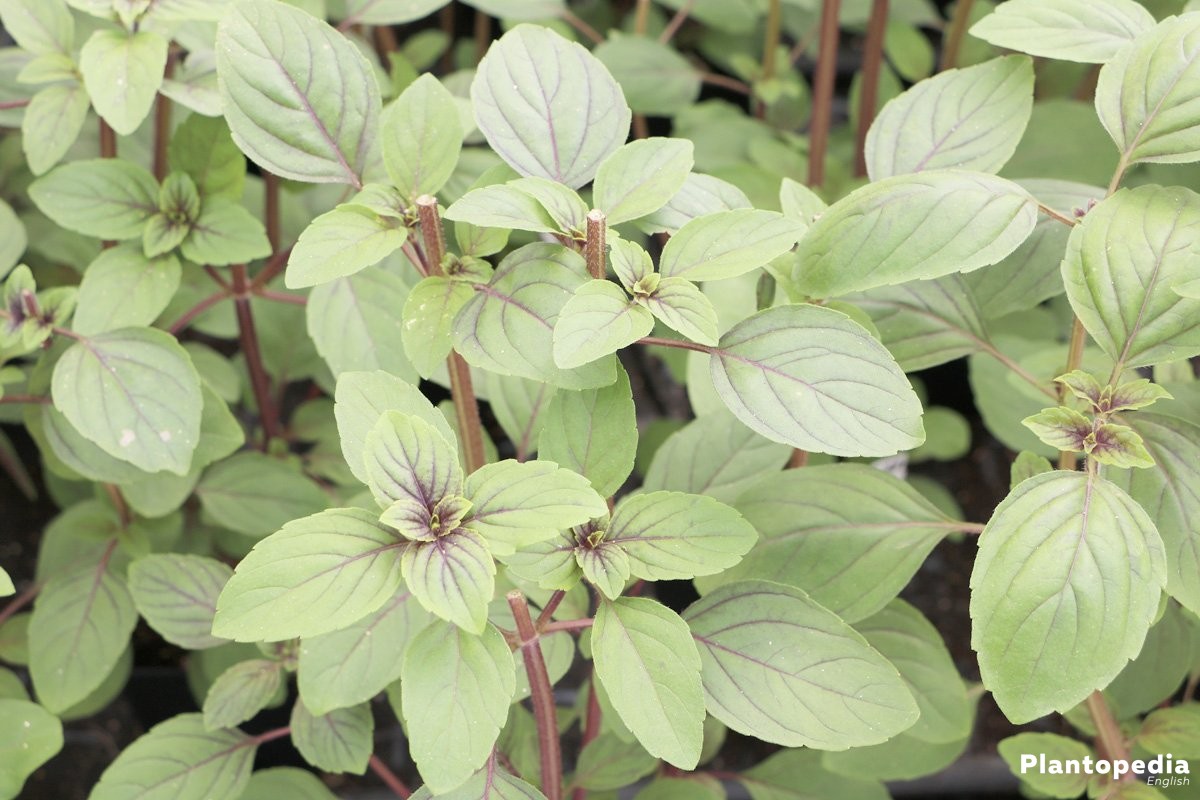
Cuttings
As an alternative to sowing, the basil can also be propagated by using cuttings. Since this method is usually not successful using a potted mother plant from the supermarket, it is recommended to take the scions from a strong bed or balcony plant.
This is how to turn a scion into a new basil herb:
- cut off five to ten shoots with a length of about ten centimeters and remove the leaves from the lower halves
- place the shoots in a translucent vessel filled with water
- position the cuttings in a light place but not exposed to the bright midday sun
- renew the water every two to three days
- as roots have developed after about a week, the cuttings can be planted in substrate together
- keep the substrate constantly moist, but not too wet
- optimal temperature: between 20 degrees Celsius and 24 degrees Celsius
- best time for propagation: April
Diseases
In terms of diseases, the basil is very sensitive and often suffers especially from special viral and fungi diseases.
Lucerne mosaic virus
Lucerne mosaic virus (alfalfa mosaic virus) causes the leaves of the basil to go yellow, causes yellow spotting and plant distortions. It occurs in most cases when cultivating inside and during severe aphid infestation. A promising method to combat this virus has not yet been disclosed, which is why the basil has to be disposed immediately in the case of an infection.
Septoria
The septoria leaf spot is a fungal infection. It usually occurs when the weather is wet and from about June onwards, it continuously causes spreading spots on the leaves. Special treatments against septoria are not known, so this fungal infection eventually causes the basil to die.
However, you can act preventive by cutting back regularly, do not put the basil in too dark places and do not use too much nitrogen fertilizer. A rain-protected location also prevents this fungal infection.
Fusarium wilt
Fusarium oxysporum, as the fusarium wilt is called in scientific context, is a fungal infection, which predominantly affects older plants and often occurs during a cultivation in the greenhouse as well as when cultivating outside. At first, only a few leaves wither until the wilting process accelerates and leaves the whole plant to die.
In that case, too, remedy can hardly be found. Keep the Ocimum basilicum cool at between 18 degrees Celsius and 20 degrees Celsius, since warm temperatures are the ideal conditions for the fusarium wilt. Cut the herb back severely and plant it in a new substrate. Only use a disinfected pot and disinfected cutting tools. Nevertheless, the chance of survival is small, but it is worth a try.
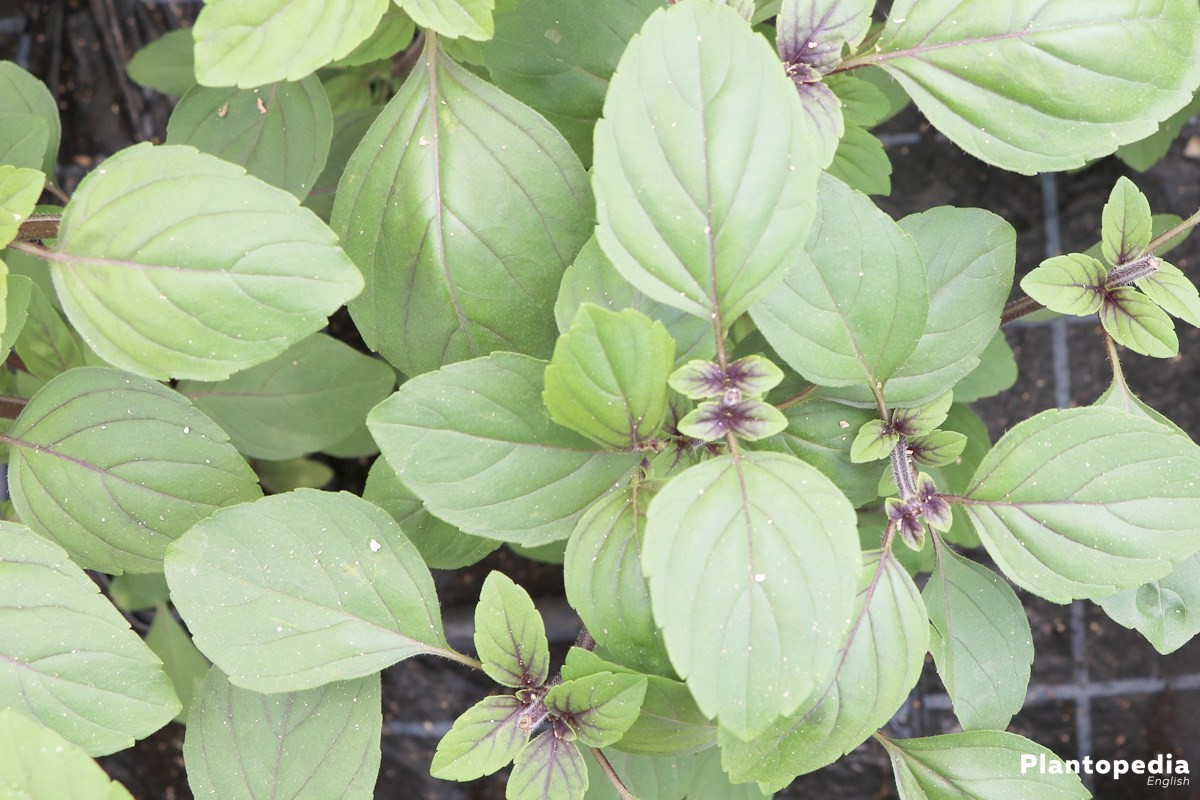
Pests
Leaf-eating pests, which love the Ocimum basilicum can be a real problem, especially in the case of outdoor cultivation.
Caterpillars
The creeping plague glands are mainly caterpillars of the knot grass (Acronyncta rumicis). They continue to eat up all the leaves gradually so that in some cases the main leaf vein is all that remains.
It is usually enough to hose the basil under high water pressure. This way, the caterpillars fall off the leaves and can be collected on the ground. Special so-called glue rings, can be attached to the shoots, where the caterpillars stick to in the attempt to cross and either die or become feed of birds themselves.
Pest control sprays with pyrethins or pyrethrum are very effective, but when consumed, also harmful to human health. After the treatment, the plant must be completely cut back to grow new shoots that are safe for consumption.
Lygus pratensis
The bug species Lygus pratensis sucks its sustenance from the basil leaf and thus absorbs any necessary supply which leads to brown spots, crippled shoots and ultimately the death of the plant. You can prepare an effective home remedy yourself using rhubarb. Rhubarb contains sennosides and oxalic acid which frightens the bugs off.
Obtain approximately 50 grams of dried rhubarb leaves, chop them and soak them in hot water for about 12 hours. Pour off the broth and use a sieve to collect the rhubarb residues. Now fill the broth into a spray bottle and spray the basil with it. Within a few days, the plant should be free from bugs.
Snails
Especially for vegetable and herbal gardens, snails are often a problem. You can entice them away from your royal herb using special attractants, which are available in the specialist trade or you can kill the pests by means of slug pellets.
Spider mites
Particularly during the winter months, when the heating air causes a dry indoor climate, an infestation with spider mites is not uncommon. They are usually found on the bottom sides of the leaves and can be identified at the latest, when white spiderweb-like carpets occur.
Hose the royal herb well and seal it in a plastic bag for two to three days. This should solve the spider mite problem.
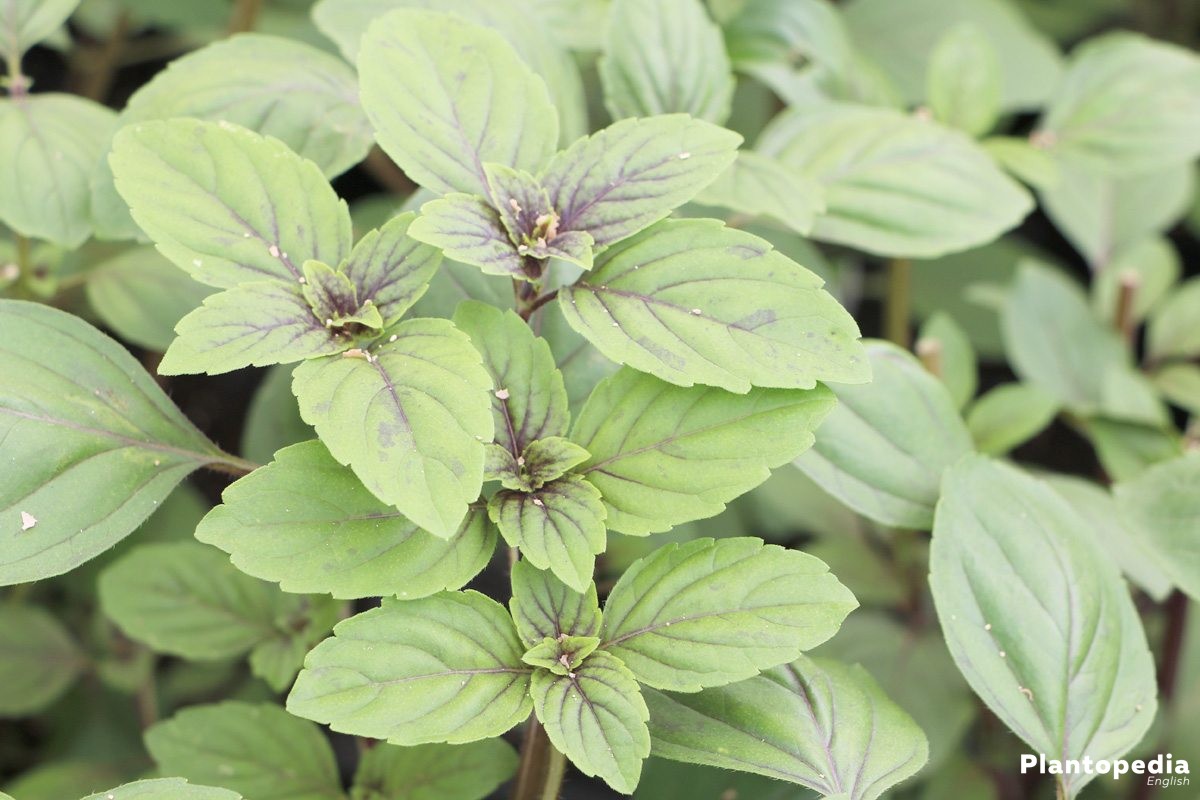
Varieties
There are two subspecies of the Ocimum basilicum, the “L- subsp. Basilicum” being the edible royal herb, which grows in Europe. Ocimum basilicum subsp. minimum L is cultivated as an ornamental plant.
However, there are numerous varieties of the Ocimum basilicum “L. subsp. Basilicum”. A classic among the varieties is the Genovese basil, which is available almost everywhere and is preferred in the Italian cuisine.
The Cinnamon variety has a cinnamon flavor while Lemon is often used as lemon basil for fish dishes.
Other known varieties include Thai and Tulsi basilicum, wild basil as well as the African blue basil.

